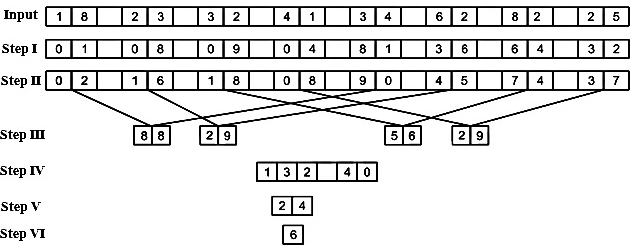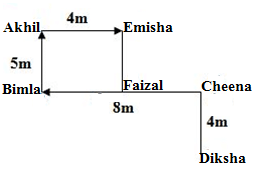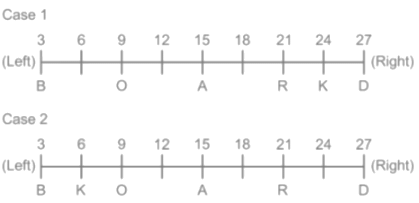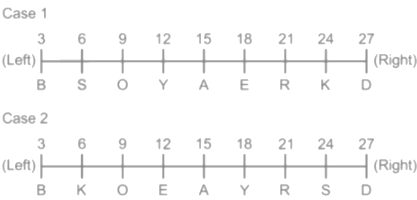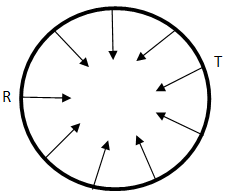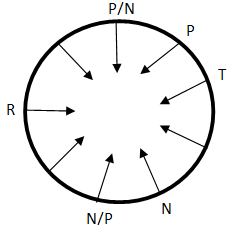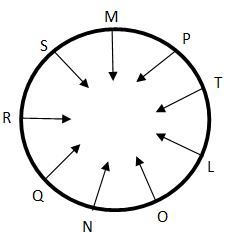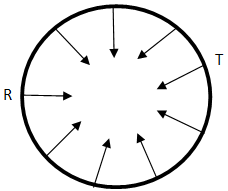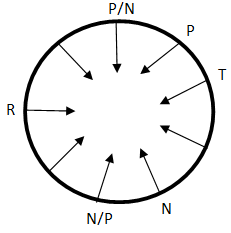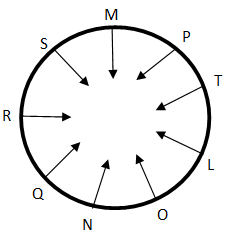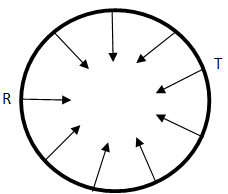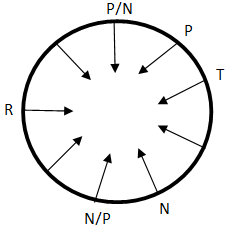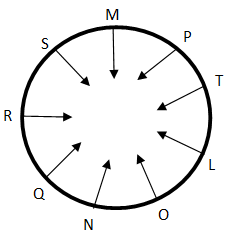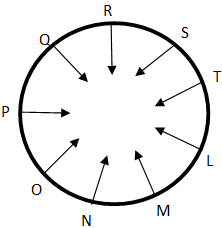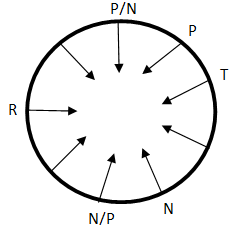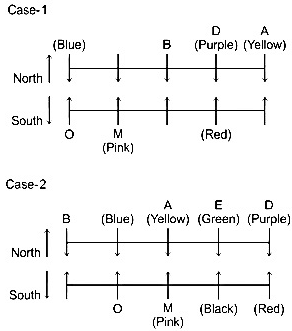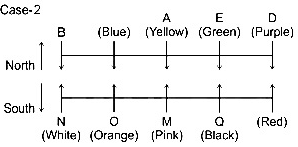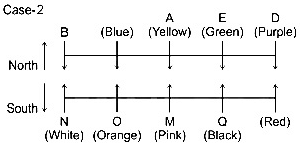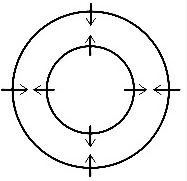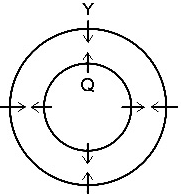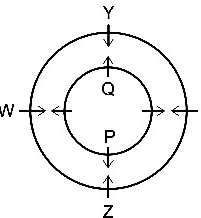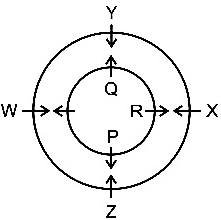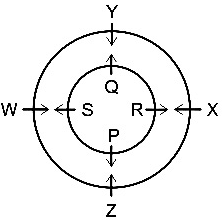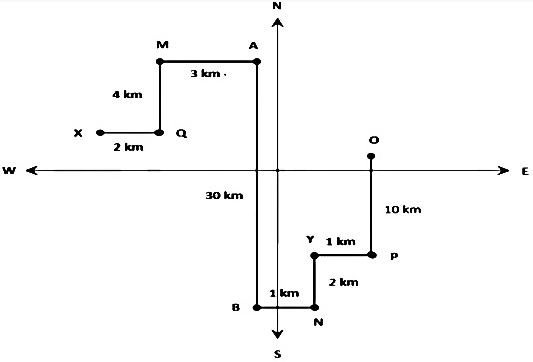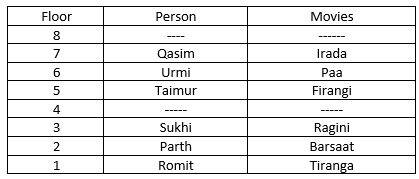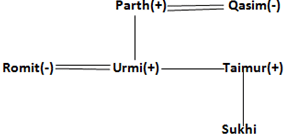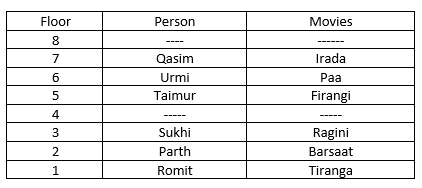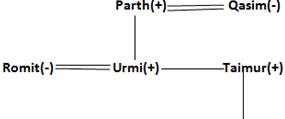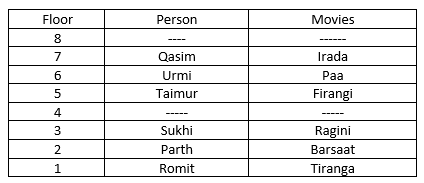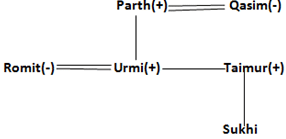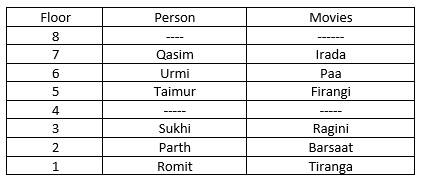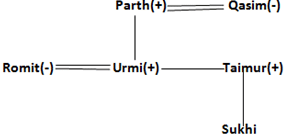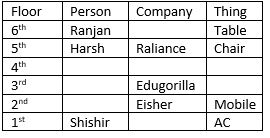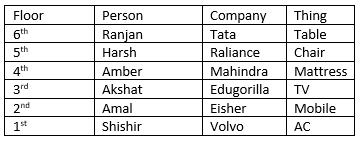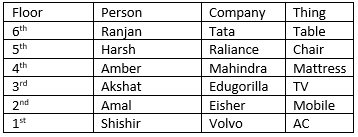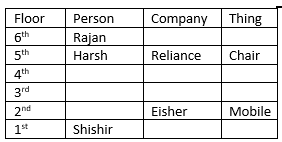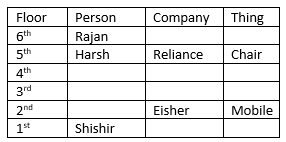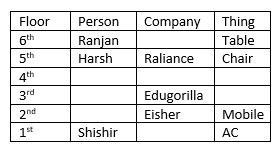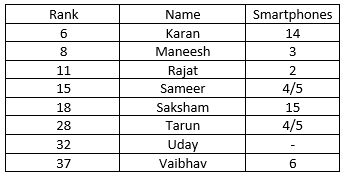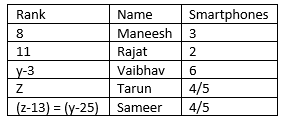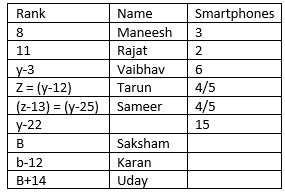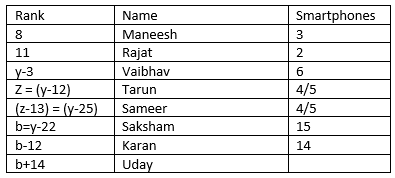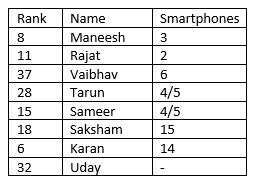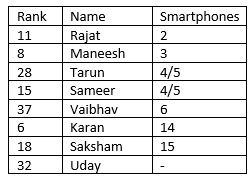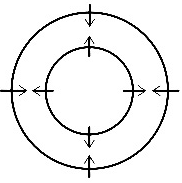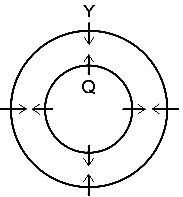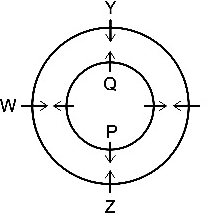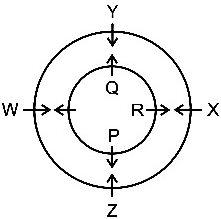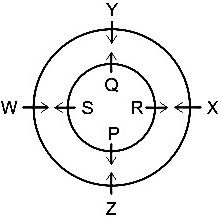IBPS RRB PO (Scale 1) Mains Mock Test - 9 - Bank Exams MCQ
30 Questions MCQ Test - IBPS RRB PO (Scale 1) Mains Mock Test - 9
Directions: Study the following information carefully and answer the questions given below.
A number arrangement machine, when given a particular input, rearranges it following a particular rule. The following is an illustration of the input and the steps of arrangement.

Step VI is the last step of the rearrangement. As per the rules followed in the above steps, find out the answers to each of the following questions for the Input given below. Ignore negative signs.
Input: 18 23 32 41 34 62 82 25
Q. Which number do we get at the second last step?

Akhil is 5m, to the north of Bimla. Bimla is 8m, to the west of Cheena. Diksha is 4m, to the south of Cheena. Emisha is 4m, to the east of Akhil. Faizal is exactly midway between Bimla and Cheena in such a way that Bimla, Cheena and Faizal form a straight line.
Q. In which direction is Diksha with respect to Akhil?
Direction: Read the given information and answer the question below.
The first 9 multiples of the number 3 are written from left to right. The letters of the word ‘BOARD’ are written in order against each odd number (One letter against one number). There are 2 letters between A and K. There are as many letters between K and E as between Y and S. S is not against number 12. The number which is against S is divisible by 4. There are 3 letters between S and E. (No letter is repeated against any number)
Q. How many four-letter meaningful word/words can be formed from letters at even positions in the final arrangement?
Study the following information to answer the given questions.
Nine friends L, M, N, O, P, Q, R, S and T are sitting around a circle facing the centre. T sits fifth to the right of R. N is not an immediate neighbour of either R or T. M sits between S and P. N sits fourth to left of the P. O sits second to the right of Q. S is not an immediate neighbour of T.
Q. Which of the following is O's position with respect to M in the anti-clockwise direction starting from M?
Study the following information to answer the given questions.
Nine friends L, M, N, O, P, Q, R, S and T are sitting around a circle facing the centre. T sits fifth to the right of R. N is not an immediate neighbour of either R or T. M sits between S and P. N sits fourth to left of the P. O sits second to the right of Q. S is not an immediate neighbour of T.
Q. Four of the following five are alike in a certain way based on their seating positions in the above arrangement and so form a group. Which is the one that does not belong to the group?
Study the following information to answer the given questions.
Nine friends L, M, N, O, P, Q, R, S and T are sitting around a circle facing the centre. T sits fifth to the right of R. N is not an immediate neighbour of either R or T. M sits between S and P. N sits fourth to left of the P. O sits second to the right of Q. S is not an immediate neighbour of T.
Q. If all the nine friends are made to sit alphabetically in the clockwise direction starting from L, positions of how many will remain unchanged (excluding L)?
Study the following information to answer the given questions.
Nine friends L, M, N, O, P, Q, R, S and T are sitting around a circle facing the centre. T sits fifth to the right of R. N is not an immediate neighbour of either R or T. M sits between S and P. N sits fourth to left of the P. O sits second to the right of Q. S is not an immediate neighbour of T.
Q. Who is second to the right of M?
Directions: Read the following information and answer the given questions:
10 people like different colours: Blue, Pink, Black, Green, White Brown, Red, Yellow, Orange and Purple are seated in two parallel rows with five people in each row such that there is equal distance between the adjacent persons and each person in one row faces the person in another row. In row 1, A, B, C, D, and E are seated facing South and in Row 2, M, N, O, P, and Q are seated facing North not necessarily in the same order. Two persons sit between O and the one who likes the Red colour. The one who faces O likes Blue colour and sits third to the right of D who likes Purple colour. M who likes Pink colour does not sit at any of the extreme ends of the row and is not an immediate neighbour of the one who likes Red colour. A who likes Yellow colour sits second to the left of B. B does not like the Blue colour. E likes the Green colour and faces the one who likes the Black colour. Q does not sit at any of the extreme ends of the row. N does not like the Red colour. Neither B nor O likes White colour. The one who likes Orange Colour does not sit at any of the extreme ends of the row.
Q. Which of the following condition is true?
Directions: Read the following information and answer the given questions:
10 people like different colours: Blue, Pink, Black, Green, White Brown, Red, Yellow, Orange and Purple are seated in two parallel rows with five people in each row such that there is equal distance between the adjacent persons and each person in one row faces the person in another row. In row 1, A, B, C, D, and E are seated facing South and in Row 2, M, N, O, P, and Q are seated facing North not necessarily in the same order. Two persons sit between O and the one who likes the Red colour. The one who faces O likes Blue colour and sits third to the right of D who likes Purple colour. M who likes Pink colour does not sit at any of the extreme ends of the row and is not an immediate neighbour of the one who likes Red colour. A who likes Yellow colour sits second to the left of B. B does not like the Blue colour. E likes the Green colour and faces the one who likes the Black colour. Q does not sit at any of the extreme ends of the row. N does not like the Red colour. Neither B nor O likes White colour. The one who likes Orange Colour does not sit at any of the extreme ends of the row.
Q. Who is sitting between M and N?
Directions: In the question below are given two statements followed by two conclusions numbered I and II. You must take the given statements to be true even if they seem to be at variance with commonly known facts. Read all the conclusions and then decide which of the given conclusions logically follow (s) from the given statements disregarding commonly known facts.
Statements:
All papers are pens.
All papers are pencils.
Conclusions:
I. Some pens are pencils.
II. All pencils are pens.
Direction: Study the following information carefully and answer the questions given below:
In a dance competition, eight girls P, Q, R, S, W, X, Y, Z are performing a group dance on stage. In that performance, one step was to make a formation of two concentric circles in such a manner that four girls P, Q, R and S are making inner one and other four girls W, X, Y and Z are making the outer circle. All the four girls of inner circle facing outside the circle and all the four girls of the outer circle facing towards the circle, in such a way that inner circle girls facing towards the outer circle girls. X is neither opposite to Y nor facing S, who is second to the right of R. Z is immediate right of W and facing P. Q is facing Y. Y and Z are not immediate neighbours.
Q. Which girl is immediate right of R?
Read the following information carefully and answer the question given below-
A number/word arrangement machine when given an input of words/numbers, rearranges them following a particular rule in each step. The following is an illustration of input and steps of rearrangement.
INPUT- 22 cold 37 unite 17 each 35 inch 26 rush 56 pinch
Step I- cold 22 37 unite each 35 inch 26 rush 56 pinch 176
Step II- each cold 37 unite 35 inch 26 rush 56 pinch 176 220
Step III- pinch each cold 37 unite 35 inch rush 56 176 220 264
Step IV- inch pinch each cold 37 unite rush 56 176 220 264 352
Step V- rush inch pinch each cold unite 56 176 220 264 352 374
Step VI- unite rush inch pinch each cold 176 220 264 352 374 561
Step VI is last step of Input.
INPUT- mild 24 66 object 69 idea 25 shut 56 value 48 union
Q. Which of the following is Step IV of the above input?
Read the following information carefully and answer the question given below-
A number/word arrangement machine when given an input of words/numbers, rearranges them following a particular rule in each step. The following is an illustration of input and steps of rearrangement.
INPUT- 22 cold 37 unite 17 each 35 inch 26 rush 56 pinch
Step I- cold 22 37 unite each 35 inch 26 rush 56 pinch 176
Step II- each cold 37 unite 35 inch 26 rush 56 pinch 176 220
Step III- pinch each cold 37 unite 35 inch rush 56 176 220 264
Step IV- inch pinch each cold 37 unite rush 56 176 220 264 352
Step V- rush inch pinch each cold unite 56 176 220 264 352 374
Step VI- unite rush inch pinch each cold 176 220 264 352 374 561
Step VI is last step of Input.
INPUT- mild 24 66 object 69 idea 25 shut 56 value 48 union
Q. Which letter/number is 5th from right end in step III?
Read the following information carefully and answer the question given below-
A number/word arrangement machine when given an input of words/numbers, rearranges them following a particular rule in each step. The following is an illustration of input and steps of rearrangement.
INPUT- 22 cold 37 unite 17 each 35 inch 26 rush 56 pinch
Step I- cold 22 37 unite each 35 inch 26 rush 56 pinch 176
Step II- each cold 37 unite 35 inch 26 rush 56 pinch 176 220
Step III- pinch each cold 37 unite 35 inch rush 56 176 220 264
Step IV- inch pinch each cold 37 unite rush 56 176 220 264 352
Step V- rush inch pinch each cold unite 56 176 220 264 352 374
Step VI- unite rush inch pinch each cold 176 220 264 352 374 561
Step VI is last step of Input.
INPUT- mild 24 66 object 69 idea 25 shut 56 value 48 union
Q. What is the sum of numbers which are 3rd from left end in step II and 3rd from right end in step VI?
Read the following information carefully and answer the question given below-
A number/word arrangement machine when given an input of words/numbers, rearranges them following a particular rule in each step. The following is an illustration of input and steps of rearrangement.
INPUT- 22 cold 37 unite 17 each 35 inch 26 rush 56 pinch
Step I- cold 22 37 unite each 35 inch 26 rush 56 pinch 176
Step II- each cold 37 unite 35 inch 26 rush 56 pinch 176 220
Step III- pinch each cold 37 unite 35 inch rush 56 176 220 264
Step IV- inch pinch each cold 37 unite rush 56 176 220 264 352
Step V- rush inch pinch each cold unite 56 176 220 264 352 374
Step VI- unite rush inch pinch each cold 176 220 264 352 374 561
Step VI is last step of Input.
INPUT- mild 24 66 object 69 idea 25 shut 56 value 48 union
Q. Which of following number is 3rd to right of 6th from right end in step III?
Directions: Study the information given below carefully and answer the questions that follow.
A and B are two points 30 km apart from each other, B being directly Southward of A. One point M lies 3 km Westward from A, and Q lies 4 km Southward from there. N lies 1 km Eastward from B, with Y 2 km to the North of N. X lies a further 2 km Westward from Q. P is 1 km to the East of Y, and 10 km to the North of P is O. If a person can only walk in straight lines and take turns only at 90o angles, answer the questions below.
Q. If a person starts his journey from a point 5 km to the South of X, how far is he from Y?
Directions: Study the information given below carefully and answer the questions that follow.
A and B are two points 30 km apart from each other, B being directly Southward of A. One point M lies 3 km Westward from A, and Q lies 4 km Southward from there. N lies 1 km Eastward from B, with Y 2 km to the North of N. X lies a further 2 km Westward from Q. P is 1 km to the East of Y, and 10 km to the North of P is O. If a person can only walk in straight lines and take turns only at 90o angles, answer the questions below.
Q. If a person has reached 5 km to the East of Q, how far is he from N?
After a long time, for reunion and to give time to family, six Sunejas family members Parth, Qasim, Romit, Sukhi, Taimur and Urmi are shooting in a same city for upcoming movies. And they live in eight different floors of building. Two of the floors in the building are vacant. The lowermost floor of the building is numbered one, the one above that is numbered two, and so on till the topmost floor is numbered eight. Each one of them is shooting for different movies namely Tiranga, Ragini, Paa, Firangi, Irada and Barsaat (but not necessarily in the same order). There are two married couple in the family. The number of floors above Urmi’s brother is same as the number of floors between Sukhi’s father and Urmi’s wife. Parth’s son Taimur lives at odd numbered floor above the floor numbered four. There are three people live between the two vacant floors. Only three floors between Urmi’s wife and the one who is shooting for Firangi. The one who is shooting for Irada lives immediately above Urmi. Only three floors are there between Urmi and Sukhi’s grandfather. The one who is shooting for Barsaat lives immediately above the one who is shooting for Tiranga. Urmi’s mother lives immediately above the one who is shooting for Paa. Taimur is the son of Parth. The number of floors between Taimur and the one who is shooting for Ragini is one. The one who is shooting for Ragini lives immediately below the one of the vacant floors. The floor number of the vacant floors are even-number. Romit is the wife of Urmi. Only two floors are there between the one who is shooting for Barsaat and Firangi. Sukhi’s grand mother lived immediately below the one of the vacant floors and not on the ground floor. Qasim neither lived on floor number 5, 2 nor floor number 3. The one who is shooting for Ragini lives on one of the floors below the floor number 4. Urmi is the uncle of Sukhi.
Q. Which of the following Statements is true with respect to the given information?
After a long time, for reunion and to give time to family, six Sunejas family members Parth, Qasim, Romit, Sukhi, Taimur and Urmi are shooting in a same city for upcoming movies. And they live in eight different floors of building. Two of the floors in the building are vacant. The lowermost floor of the building is numbered one, the one above that is numbered two, and so on till the topmost floor is numbered eight. Each one of them is shooting for different movies namely Tiranga, Ragini, Paa, Firangi, Irada and Barsaat (but not necessarily in the same order). There are two married couple in the family. The number of floors above Urmi’s brother is same as the number of floors between Sukhi’s father and Urmi’s wife. Parth’s son Taimur lives at odd numbered floor above the floor numbered four. There are three people live between the two vacant floors. Only three floors between Urmi’s wife and the one who is shooting for Firangi. The one who is shooting for Irada lives immediately above Urmi. Only three floors are there between Urmi and Sukhi’s grandfather. The one who is shooting for Barsaat lives immediately above the one who is shooting for Tiranga. Urmi’s mother lives immediately above the one who is shooting for Paa. Taimur is the son of Parth. The number of floors between Taimur and the one who is shooting for Ragini is one. The one who is shooting for Ragini lives immediately below the one of the vacant floors. The floor number of the vacant floors are even-number. Romit is the wife of Urmi. Only two floors are there between the one who is shooting for Barsaat and Firangi. Sukhi’s grand mother lived immediately below the one of the vacant floors and not on the ground floor. Qasim neither lived on floor number 5, 2 nor floor number 3. The one who is shooting for Ragini lives on one of the floors below the floor number 4. Urmi is the uncle of Sukhi.
Q. Who amongst the following lives exactly between the fourth floor and the one who is shooting for Tiranga?
After a long time, for reunion and to give time to family, six Sunejas family members Parth, Qasim, Romit, Sukhi, Taimur and Urmi are shooting in a same city for upcoming movies. And they live in eight different floors of building. Two of the floors in the building are vacant. The lowermost floor of the building is numbered one, the one above that is numbered two, and so on till the topmost floor is numbered eight. Each one of them is shooting for different movies namely Tiranga, Ragini, Paa, Firangi, Irada and Barsaat (but not necessarily in the same order). There are two married couple in the family. The number of floors above Urmi’s brother is same as the number of floors between Sukhi’s father and Urmi’s wife. Parth’s son Taimur lives at odd numbered floor above the floor numbered four. There are three people live between the two vacant floors. Only three floors between Urmi’s wife and the one who is shooting for Firangi. The one who is shooting for Irada lives immediately above Urmi. Only three floors are there between Urmi and Sukhi’s grandfather. The one who is shooting for Barsaat lives immediately above the one who is shooting for Tiranga. Urmi’s mother lives immediately above the one who is shooting for Paa. Taimur is the son of Parth. The number of floors between Taimur and the one who is shooting for Ragini is one. The one who is shooting for Ragini lives immediately below the one of the vacant floors. The floor number of the vacant floors are even-number. Romit is the wife of Urmi. Only two floors are there between the one who is shooting for Barsaat and Firangi. Sukhi’s grand mother lived immediately below the one of the vacant floors and not on the ground floor. Qasim neither lived on floor number 5, 2 nor floor number 3. The one who is shooting for Ragini lives on one of the floors below the floor number 4. Urmi is the uncle of Sukhi.
Q. Which of the following pair represents vacant floors?
After a long time, for reunion and to give time to family, six Sunejas family members Parth, Qasim, Romit, Sukhi, Taimur and Urmi are shooting in a same city for upcoming movies. And they live in eight different floors of building. Two of the floors in the building are vacant. The lowermost floor of the building is numbered one, the one above that is numbered two, and so on till the topmost floor is numbered eight. Each one of them is shooting for different movies namely Tiranga, Ragini, Paa, Firangi, Irada and Barsaat (but not necessarily in the same order). There are two married couple in the family. The number of floors above Urmi’s brother is same as the number of floors between Sukhi’s father and Urmi’s wife. Parth’s son Taimur lives at odd numbered floor above the floor numbered four. There are three people live between the two vacant floors. Only three floors between Urmi’s wife and the one who is shooting for Firangi. The one who is shooting for Irada lives immediately above Urmi. Only three floors are there between Urmi and Sukhi’s grandfather. The one who is shooting for Barsaat lives immediately above the one who is shooting for Tiranga. Urmi’s mother lives immediately above the one who is shooting for Paa. Taimur is the son of Parth. The number of floors between Taimur and the one who is shooting for Ragini is one. The one who is shooting for Ragini lives immediately below the one of the vacant floors. The floor number of the vacant floors are even-number. Romit is the wife of Urmi. Only two floors are there between the one who is shooting for Barsaat and Firangi. Sukhi’s grandmother lived immediately below the one of the vacant floors and not on the ground floor. Qasim neither lived on floor number 5, 2 nor floor number 3. The one who is shooting for Ragini lives on one of the floors below the floor number 4. Urmi is the uncle of Sukhi.
Q. Four of the following five are alike in a certain way and so form a group. Which one of the following does not belong to the group?
After a long time, for reunion and to give time to family, six Sunejas family members Parth, Qasim, Romit, Sukhi, Taimur and Urmi are shooting in the same city for upcoming movies. And they live in eight different floors of building. Two of the floors in the building are vacant. The lowermost floor of the building is numbered one, the one above that is numbered two, and so on till the topmost floor is numbered eight. Each one of them is shooting for different movies namely Tiranga, Ragini, Paa, Firangi, Irada and Barsaat (but not necessarily in the same order). There are two married couple in the family. The number of floors above Urmi’s brother is same as the number of floors between Sukhi’s father and Urmi’s wife. Parth’s son Taimur lives at odd numbered floor above the floor numbered four. There are three people live between the two vacant floors. Only three floors between Urmi’s wife and the one who is shooting for Firangi. The one who is shooting for Irada lives immediately above Urmi. Only three floors are there between Urmi and Sukhi’s grandfather. The one who is shooting for Barsaat lives immediately above the one who is shooting for Tiranga. Urmi’s mother lives immediately above the one who is shooting for Paa. Taimur is the son of Parth. The number of floors between Taimur and the one who is shooting for Ragini is one. The one who is shooting for Ragini lives immediately below the one of the vacant floors. The floor number of the vacant floors are even-number. Romit is the wife of Urmi. Only two floors are there between the one who is shooting for Barsaat and Firangi. Sukhi’s grandmother lived immediately below the one of the vacant floors and not on the ground floor. Qasim neither lived on floor number 5, 2 nor floor number 3. The one who is shooting for Ragini lives on one of the floors below the floor number 4. Urmi is the uncle of Sukhi.
Q. How many floors are between Urmi’s mother floor and Sukhi’s floor?
Direction: Study the following information carefully and answer the question given below:
Six person, Amal, Akshat, Shishir, Amber, Harsh and Ranjan live on six different floor of a building, starting from floor 1 to floor 6. No two person works in the different companies namely Volvo, Reliance, Mahindra, Tata, Edugorilla, Eisher. They sold the different things which are Table, Mobile, TV, AC, Mattress, and Chair.
1) Neither Akshat live on any even numbered floor nor the person who works in Volvo.
2) The person who sold AC lives two floors below the person who works in Edugorilla.
3) The person who lives on odd numbered floor works in Edugorilla and lives three floors below the person who sold table.
4) The person who works in Mahindra lives on even numbered floor and did not sell TV or table.
5) Shishir lives four floors below the person who sold the chair.
6) Ranjan lives four floors above the person who works in Eisher and Harsh works in Reliance.
7) Amal neither works in Mahindra nor in Edugorilla.
8) The person who sold the mobile lives three floors below the person who works in Reliance and both of them does not live on extreme floors.
Q. Who works in Eisher?
Direction: Study the following information carefully and answer the question given below:
Six person, Amal, Akshat, Shishir, Amber, Harsh and Ranjan live on six different floor of a building, starting from floor 1 to floor 6. No two person works in the different companies namely Volvo, Reliance, Mahindra, Tata, Edugorilla, Eisher. They sold the different things which are Table, Mobile, TV, AC, Mattress, and Chair.
1) Neither Akshat live on any even numbered floor nor the person who works in Volvo.
2) The person who sold AC lives two floors below the person who works in Edugorilla.
3) The person who lives on odd numbered floor works in Edugorilla and lives three floors below the person who sold table.
4) The person who works in Mahindra lives on even numbered floor and did not sell TV or table.
5) Shishir lives four floors below the person who sold the chair.
6) Ranjan lives four floors above the person who works in Eisher and Harsh works in Reliance.
7) Amal neither works in Mahindra nor in Edugorilla.
8) The person who sold the mobile lives three floors below the person who works in Reliance and both of them does not live on extreme floors.
Q. Who sold the AC?
Direction: Study the following information carefully and answer the question given below:
Six person, Amal, Akshat, Shishir, Amber, Harsh and Ranjan live on six different floor of a building, starting from floor 1 to floor 6. No two person works in the different companies namely Volvo, Reliance, Mahindra, Tata, Edugorilla, Eisher. They sold the different things which are Table, Mobile, TV, AC, Mattress, and Chair.
1) Neither Akshat live on any even numbered floor nor the person who works in Volvo.
2) The person who sold AC lives two floors below the person who works in Edugorilla.
3) The person who lives on odd numbered floor works in Edugorilla and lives three floors below the person who sold table.
4) The person who works in Mahindra lives on even numbered floor and did not sell TV or table.
5) Shishir lives four floors below the person who sold the chair.
6) Ranjan lives four floors above the person who works in Eisher and Harsh works in Reliance.
7) Amal neither works in Mahindra nor in Edugorilla.
8) The person who sold the mobile lives three floors below the person who works in Reliance and both of them does not live on extreme floors.
Q. Who works in Edugorilla?
Direction: Study the following information carefully and answer the question given below:
Six person, Amal, Akshat, Shishir, Amber, Harsh and Ranjan live on six different floor of a building, starting from floor 1 to floor 6. No two person works in the different companies namely Volvo, Reliance, Mahindra, Tata, Edugorilla, Eisher. They sold the different things which are Table, Mobile, TV, AC, Mattress, and Chair.
1) Neither Akshat live on any even numbered floor nor the person who works in Volvo.
2) The person who sold AC lives two floors below the person who works in Edugorilla.
3) The person who lives on odd numbered floor works in Edugorilla and lives three floors below the person who sold table.
4) The person who works in Mahindra lives on even numbered floor and did not sell TV or table.
5) Shishir lives four floors below the person who sold the chair.
6) Ranjan lives four floors above the person who works in Eisher and Harsh works in Reliance.
7) Amal neither works in Mahindra nor in Edugorilla.
8) The person who sold the mobile lives three floors below the person who works in Reliance and both of them does not live on extreme floors.
Q. Who lives on 4th floor?
This question consists of a question and two statements numbered I and II given below it. You have to decide whether the data given in the statements are sufficient to answer the question. Read both the statements and choose the most appropriate option.
In which month (of the same year) was Ritesh appearing for an exam?
Statement I: Ritesh's brother correctly remembers that he appeared for the exam after April but before November and that the month of his exam had exactly 30 days.
Statement II: Ritesh' s sister correctly remembers that he appeared for the exam after June but before December and that the month of his exam did not have 31 days.
Directions: Read the following information carefully and answer the question that follow.
In class, there are 8 students who have smartphones. Rajat is 11th from the top in the class with 2 smartphones. Maneesh is 8th from the top and has 3 smartphones. Vaibhav ranks 4th from the bottom in the class and has 6 smartphones. Sameer is 13 ranks above Tarun in the class. These two, Sameer and Tarun have 4 & 5 smartphones not necessarily in the same order. Tarun is 9 ranks less than that of Vaibhav and 10 ranks ahead of the person who has 15 smartphones. Uday is 14 ranks ahead of Saksham and Karan has 1 smartphone less than Saksham and 12 ranks below to Saksham. Neither of Karan nor Uday has 8 smartphones. Saksham has an equal number of phones as is the rank of Sameer.
Q. Choose the correct option when names are arranged in the ascending order of their ranks.
Direction: Study the following information carefully and answer the questions given below:
In a dance competition, eight girls P, Q, R, S, W, X, Y, Z are performing a group dance on stage. In that performance, one step was to make a formation of two concentric circles in such a manner that four girls P, Q, R and S are making inner one and other four girls W, X, Y and Z are making the outer circle. All the four girls of inner circle facing outside the circle and all the four girls of the outer circle facing towards the circle, in such a way that inner circle girls facing towards the outer circle girls. X is neither opposite to Y nor facing S, who is second to the right of R. Z is immediate right of W and facing P. Q is facing Y. Y and Z are not immediate neighbours.
Q. Which girl is immediate left of Q?
This question consists of a question and two statements numbered I and II given below it. You have to decide whether the data given in the statements are sufficient to answer the question. Read both the statements and choose the most appropriate option.
Is M the Aunt of T?
Statement I: K is the father of M. K is the brother of J. J is the daughter of D. N is the sister of D. T is the daughter of N.
Statement II: I is the father of T. N is the mother of T. D is the brother of N. D has two children J and K. M is married to D.


